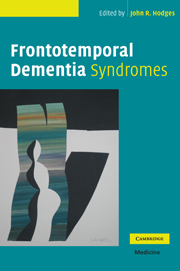Book contents
- Frontmatter
- Contents
- List of contributors page
- Preface
- 1 Overview of frontotemporal dementia
- 2 Epidemiology of frontotemporal dementia
- 3 Clinical presentations of frontotemporal dementia
- 4 Overlap syndromes
- 5 The neuropsychology of frontotemporal dementia
- 6 Neuroimaging and other investigative findings
- 7 The histopathology of frontotemporal dementia
- 8 Molecular neuropathology in familial and sporadic frontotemporal dementia
- 9 The genetics of frontotemporal dementia
- 10 Psychological interventions in frontotemporal dementia
- Index
4 - Overlap syndromes
Published online by Cambridge University Press: 05 August 2016
- Frontmatter
- Contents
- List of contributors page
- Preface
- 1 Overview of frontotemporal dementia
- 2 Epidemiology of frontotemporal dementia
- 3 Clinical presentations of frontotemporal dementia
- 4 Overlap syndromes
- 5 The neuropsychology of frontotemporal dementia
- 6 Neuroimaging and other investigative findings
- 7 The histopathology of frontotemporal dementia
- 8 Molecular neuropathology in familial and sporadic frontotemporal dementia
- 9 The genetics of frontotemporal dementia
- 10 Psychological interventions in frontotemporal dementia
- Index
Summary
What is an overlap syndrome?
For centuries one of the main objectives of medicine has been to identify, define and describe distinct diseases, each characterised by a specific cause, particular pathological mechanisms and at least some pathognomonic features that can help in distinguishing it from the others. To a certain degree, this approach reflects the academic zest for parsimonious explanations and descriptive elegance, as well as the more general human need for clear, mutually exclusive, distinctive categories. The ultimate hope, however, is that dividing diseases into clear diagnostic categories can help identify specific risk factors, which can be addressed by preventive strategies, and characterise underlying pathological processes, which can be influenced by treatment. One of the clearest and most influential examples of this approach is so-called Koch's postulates (Falkow, 2004; Mazzarello, 2004). Although originally designed to prove the causal link between an infectious agent and an illness, in a modified form they have been applied to other types of diseases (Monaco et al., 2005).
In practice, however, such clear and objective boundaries are often difficult to find. Medical literature abounds in debates, whether a certain disease constitutes a single nosological entity (albeit divided into different subgroups) or different entities (although possibly related to each other). Moreover, in many cases patients may present with a mixture of symptoms of two different diagnostic categories. This is not a rare phenomenon: the literature on different types of “overlap syndromes” in the medical database includes almost 4000 entries. However, despite the popularity of the term and its intuitive plausibility, the notion of an “overlap syndrome” is often ill defined and can encompass different types of relationships:
• A coincidence of two diseases in the same patient can occur simply by chance: in common conditions one can expect that a number of patients is likely to suffer from more than one disease at the same time. In the case of rare conditions the likelihood of a co-occurrence is of course much smaller, but a publication bias towards the rare and extraordinary causes the overlap cases to be reported more often than the straightforward ones.
• Two different diseases might share one or more risk factors; such as age, exposure to toxic substances, infections or a genetic predisposition; this case can be illustrated by the recent debates about the importance of vascular risk factors for the development of AD (Korczyn, 2005).
- Type
- Chapter
- Information
- Frontotemporal Dementia Syndromes , pp. 80 - 101Publisher: Cambridge University PressPrint publication year: 2007
- 1
- Cited by



